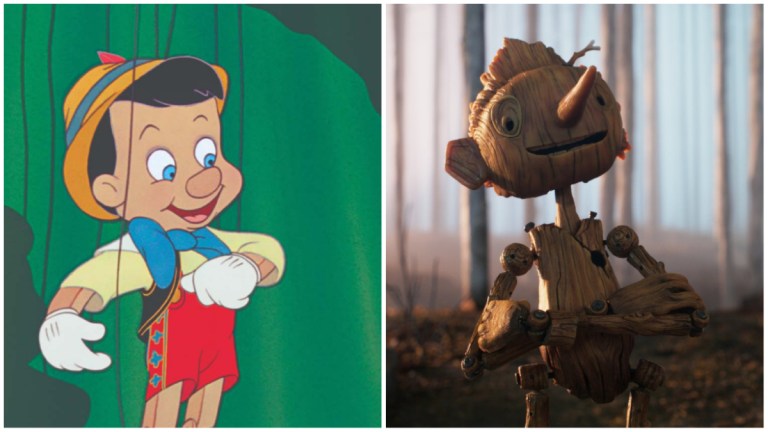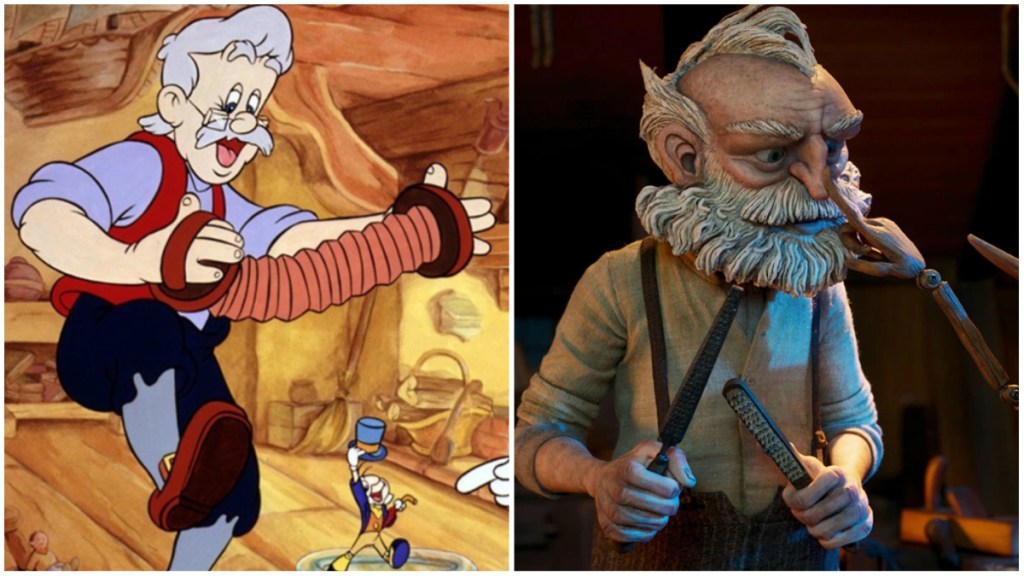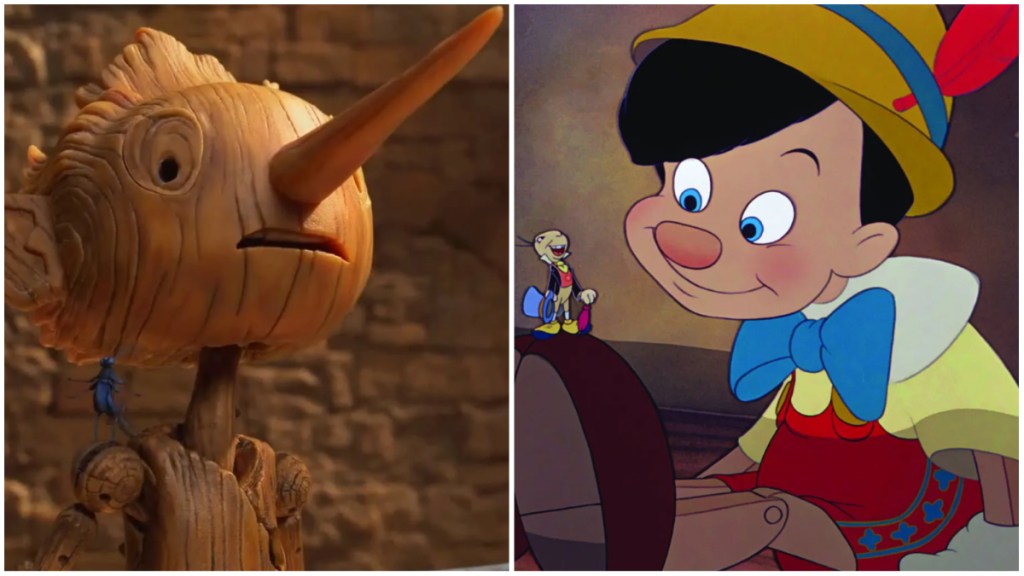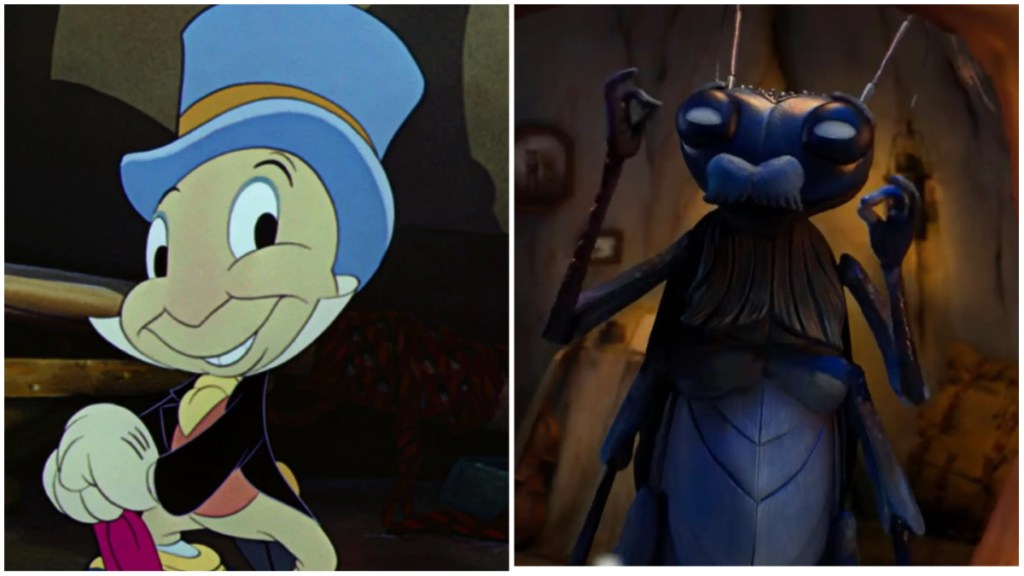Guillermo del Toro’s Pinocchio vs. Disney: What Are the Differences?
More than 80 years after Walt Disney seemed to crystallize the Pinocchio tale for American audiences, Guillermo del Toro makes it his own.

This article contains spoilers for Guillermo del Toro’s Pinocchio, as well as both the 1940 and 2022 Disney versions.
“I have no strings on me,” Pinocchio proudly declared in 1940 while walking down the steps of a carnival show. The scene helped launch one of the most beloved songs in Walt Disney’s animated musical, and one which is still referenced to this day in things like Avengers movies. However, the line is a bit inaccurate. For generations of children the world over, and particularly in the United States, Pinocchio would always have strings on him: and they came in the shape of Disney nostalgia.
As only Disney’s second animated feature film, Pinocchio was the launchpad of “When You Wish Upon a Star,” and more than eight decades later that remains the company’s unofficial anthem. And as far as most children’s imaginations are concerned, the red, white, and yellow color design of a cheerful Pinocchio dancing with a sweet Geppetto supplanted anything that could come from the words of Carlo Collodi, who saw his book The Adventures of Pinocchio published in 1883.
But Guillermo del Toro wasn’t most children. Born in Mexico and with a seeming affinity for outsiders and creatures that saw the world (or were seen by it) as something unusual, del Toro grew up adoring The Adventures of Pinocchio text. And as an adult, it’s been a lifelong passion to eventually adapt it in his own image. That wish has now at last come true thanks to Netflix’s deep pockets, which allowed del Toro to craft alongside director Mark Gustafson a beautiful, stop-motion wonder. For the first time in nearly a century, someone has made the little wooden boy who dreams of becoming real so much their own that Netflix eventually titled the film Guillermo del Toro’s Pinocchio.
Ironically, the new film was also released in the same year as Disney’s own update of the 1940 film, a much less surprising (or interesting) retread from the studio’s live-action remake factory, albeit “live-action” is a bit of a misnomer this time. While Tom Hanks is definitely playing Geppetto in the flesh and blood, he is acting against mostly computer-generated animations, including a picture-perfect recreation of old Walt’s Pinocchio from 1940.
Still, how do these three movies intersect and how do they differ? How does del Toro break away from what came before… and where does he intriguingly intersect with choices Disney also made in its 2022 update that had director Robert Zemeckis at the helm? Well, dear reader, keep scrolling and we’ll unpack exactly how they differ, as well as when they surprisingly converge.

What Is Pinocchio to Gepetto?
Perhaps the biggest change from the lore surrounding Pinocchio—both onscreen and in the original Italian text—is something del Toro and Zemeckis’ 2022 adaptations wound up agreeing on: Geppetto makes Pinocchio not because he is a simple toymaker, a la the 1940 film, or a puppeteer as in the 1883 book, but because he is grieving the loss of a son who lived before Pinocchio.
This motivation, however, feels twee and thin in the Disney live-action remake. It’s a meager ledge from which Hanks’ natural gravitas is left to grip while developing a motivation for the toymaker. Now he’s a sweetly sad old-timer who vaguely mourns a lost son. That lad’s loss is also kept similarly vague and gentle during one tacked on song. Otherwise, nothing about the loss of a child informs the Geppetto of Disney’s newest Pinocchio.
By contrast, Guillermo del Toro’s Pinocchio begins not with Pinocchio or even the talking cricket who narrates the story (more on him in a bit). Rather it starts with a long prologue that lingers on the loss felt by Geppetto, who is voiced with a wounded cantankerousness by David Bradley. We learn during extended, melancholic flashbacks that Geppeto’s son was named Carlo (likely an homage to the writer who created the Pinocchio character) and he was an idyllic youth who grew up during harsh times in the waning days of the First World War. Even young Carlo’s most innocent distractions, such as riding a swing in the forest, is sullied by the sight of bomber planes above.
Eventually, Carlo dies tragically during a bombing raid that destroys a nearby church. All that’s left of the ruins is Christ on a Cross. As a consequence, Bradley’s Geppetto is animated as falling down the bottom of a bottle, spending every day for more than 10 years at Carlo’s gravesite with nondescript liquor in hand.
When Gepetto makes Pinocchio, it’s not done as an act of love or even benign generosity for the children of his village. It’s a drunken moment of bitterness in which he cuts down the tree Carlo was buried by (the same tree that the lad used to swing from). Geppetto then turns the wood from its trunk into a misshapen and ghastly thing in an act of petty revenge against the world. Indeed, Pinocchio’s creation has more in common with old horror movies than Disney. A shot of lightning outside the window as bark is turned into Pinocchio’s head looks taken practically in total from James Whale’s Frankenstein (1931). The film’s talking cricket even cries out, “It’s a house of horrors!”
When a fairy grants life to Pinocchio, then, it’s not as a gift for Geppetto; it’s a mercy from the Spirits of the Forest—forming into an alien-looking fairy/wood sprite that speaks with many voices at once–who hope to save the old man from self-destruction. Geppetto also does not initially warm to the sight of Pinocchio. He recoils in fear.
Of course, this being the story of Pinocchio, Geppetto ultimately adopts Pinocchio as his son. However, their relationship is always somewhat strained and tragic; Geppetto desperately wants Pinocchio to be Carlo and is always crestfallen when the wooden boy fails to live up to the real boy’s shadow.

What Is Pinocchio to the World?
Of course how Pinocchio sees the world, and how it sees him, is entirely different from Geppetto’s own struggles. Disney’s Pinocchio is generally a sweet and innocent lad who is constantly led astray by the circumstances around him. There is Honest John, the fast-talking fox who hoodwinks Pinocchio into joining a life of show business at the circus (the talking fox does appear in the original book but he isn’t named Honest John); then there’s the Coachman who tricks Pinocchio into coming to Pleasure Island where naughty boys are turned into donkeys (also in the book); and even the whale that swallows him gets the opportunity because of events largely outside of Pinocchio’s control.
Del Toro’s wooden boy, by contrast, leans into the subplot about Pinocchio being a willful child prone to make mistakes. The 1940 film has the Blue Fairy reprimand Pinocchio for lying, which causes his nose to grow. But she then turns his nose back to normal. In the 2022 Zemeckis remake, Pinocchio is inexplicably rewarded for lying by using the elongated nose to escape from a tight spot while imprisoned by a carnival barker. But in Guillermo del Toro’s Pinocchio? The growing nose transforms into a ghastly asymmetrical tree branch the more times the kid lies, and it can only be fixed by Geppetto’s blade whittling it back down to its former shape.
The lad is also never entirely bothered by this fact or that he repeatedly ends up briefly dead because of his mistakes (more on that below). He also seems to lack much of the Disney variation’s interest in becoming a real boy. He wants to be loved like a real boy but he resents being constantly compared to the “real” Carlo by Gepetto.
When he leaves the safety of his father’s house, he is also immediately treated with suspicion and fear. Del Toro’s Pinocchio is set during the rise of fascism in Italy, and the first time Pinocchio walks around a far grayer village than the sunny one in the two Disney movies, he is treated as a freak and monstrosity by a priest in the ruined church and authority figures serving il Duce Benito Mussolini.
However, these same authority figures see opportunity in manipulating Pinocchio’s innocence, first as a propaganda tool and then as a key to possible immortality. In the case of the former, the talking Fox and Cat of the book, as well as various other characters, are combined into a human named Count Volpe (Christoph Waltz), who keeps a fox head on his cane and has canine-shaped hair.
Volpe puts Pinocchio into a circus act like Honest John and the Stromboli character in Disney’s multiple versions of Pinocchio, however the songs are not sweet little ditties about having no strings. Instead they become increasingly jingoistic love letters to Mussolini until one night Pinocchio goes rogue and wastes one of his many lives by mocking il Duce to his face!
Intriguingly, del Toro does not adapt the “Pleasure Island” (or “Toyland” in the book) vignette, which did inspire sincere nightmare fuel in the 1940 film as donkeys with the voices of little boys are taunted and condemned by demonic authority figures. Perhaps del Toro suspected he could not top the one sequence where Disney opted to go seriously into the horror?
Then again, del Toro seems to be using the fragile innocence of Pinocchio to say something about this even more fragile world, because like Pan’s Labyrinth before it, Pinocchio is a story of childhood daydreams juxtaposed against the mouth of hell.

A Case of Crickets
In perhaps homage to Disney, Guillermo del Toro’s Pinocchio is narrated by the talking cricket who is assigned by the wood sprite fairy to be Pinocchio’s conscience. However, there are distinct differences between Disney’s Jiminy Cricket and del Toro’s Sebastian J. Cricket. The latter’s abbreviated middle name is likely an homage to Jiminy, but whereas Jiminy is depicted to be a bit of a scamp and a vagabond who sneaks his way into Geppetto’s workshop, Sebastian J. Cricket (voiced by Ewan McGregor) is made of sterner stuff.
By his own self-description, Sebastian is a novelist, a raconteur, and ultimately a gentleman (gentlecricket?) who’s lived a life of refined adventure around the world. When we meet him in the Netflix movie, he is not a tramp looking to stay warm for the night in Geppetto’s home, but a worldly fellow who’s returned home to his hollow when Geppetto so rudely cuts it down to carve the tree into Pinocchio’s body.
In fact, Sebastian is quite perturbed to wind up in “a house of horrors” when he sees the Spirits of the Forest turn into a wood sprite. And while the original Jiminy was smitten by the fairy, agreeing to be Pinocchio’s conscience because the fairy sure is purdy, Sebastian haughtily declines until the wood sprite promises to grant him one wish should he succeed in doing his best to guide Pinocchio. Amusingly, Sebastian sees this as the jackpot—a chance to ensure that his memoirs are published!
Of course he winds up using that wish for something more profound… like bringing Pinocchio back from the dead.
Matters of Life and Death
In one of the biggest changes from the book and its Disney counterparts, Guillermo del Toro’s Pinocchio is something of a revenant, or at least a cat with nine lives. As he quickly learns after disobeying Geppetto and attempting to stay in showbiz, being dead kind of sucks. It’s also temporary… at first.
Because Pinocchio was created by magic, we learn that del Toro’s wooden child constantly is sent after he dies to a subterranean afterlife that is ruled over by a sphinx-like creature named, appropriately enough, Death (Tilda Swinton). Death reveals that she is sisters with the fairy who granted Pinocchio life but she cannot treat Pinocchio like a real boy, because he was not born and therefore cannot die. At least not immediately. For reasons that are not entirely clear, Pinocchio is granted a finite number of extra lives which bring him back from the great beyond—until they run out.
This addition feels mostly like a bizarre but appropriate del Toro flourish—a tangent that’s largely about style and the narrative/thematic opportunities it presents at the ending. Still, it does have some precedent in the original Italian text. Apparently in the original serialized version of The Adventures of Pinocchio published across several magazines, the wooden boy is hanged and killed for his many crimes and selfish deeds. Notes of complaint caused Collodi to later alter the story so that Pinocchio proves his worth and is transformed into a real boy by the magical fairy.
That… is not how Guillermo del Toro’s Pinocchio ends.
An Ending and Life Changed
The closest adaptation to The Adventures of Pinocchio’s final ending remains Walt Disney’s 1940 movie. After a series of misadventures, including Pinocchio and Geppetto being swallowed whole by a whale, Pinocchio has proven his worth and is allowed to become a real boy by the fairy.
Once again, both del Toro’s movie and Zemeckis’ 2022 remake of Disney’s classic come to an interesting conclusion that is counterintuitive to this… what if he didn’t? What if Pinocchio did not become a “real” boy? Both 2022 adaptations of the story were created after more than a half century of scholarship explored how the story of Pinocchio has played to young children born into LGBTQ+ communities and other minority groups. There are many kids to this day who can relate to Pinocchio’s desire to be “normal,” even as that heteronormative definition has been challenged.
In the case of Disney and Zemeckis’ 2022 remake, the solution feels unfortunately half-baked and wishy-washy. Pinocchio saves Hanks’ Geppetto and their beloved tuxedo cat from the whale and all realize Pinocchio’s value. Jiminy Cricket (voiced by Joseph Gordon-Levitt in the remake) then tells the audience that maybe he became a “real boy.” Or maybe not. The cricket’s unsure. Basically, Disney will let audiences imagine whatever ending appeals most to the viewer without alienating any potential customers.
Conversely, del Toro is speaking to something that he’s personally felt and infused in most of the films throughout his career: that to be “different” is to be glorious. Who wants the 1950s white bread all-American man in Creature from the Black Lagoon when you can have Gil-Man? Hence the Best Picture winner of 2017, The Shape of Water. And who wants to be “a real boy” when being made of wood makes Pinocchio so special that even il Duce is riveted by his individuality?
So Guillermo del Toro’s Pinocchio ends with the wooden boy using his last life to save Geppetto from a sea creature—which appears more Lovecraftian nightmare than simple whale—and then dying. And instead of Sebastian J. Cricket using his one wish for a deal with Doubleday, he wishes to bring Pinocchio back from the other side one last time. Only after realizing he might’ve lost the boy forever does Geppetto recognize he loves Pinocchio for who he is, wooden nose and all, as opposed to for who he is not—the “normal” but deceased Carlo.
After Pinocchio is risen, and fully accepted for his differences, a happy ending can at last be achieved… and we do mean an ending as the film flashes forward to Pinocchio caring for Geppetto until his death, and then doing the same for Sebastian J.. Cricket. In the end, Sebastian even gets his old home back, having his remains placed in a matchstick box and placed inside Pinocchio’s innards… near his heart.
To be normal, to be real, means accepting mortality as Geppetto does when he admits Carlo is never coming back in the form of Pinocchio. And by accepting Geppetto and Sebastian’s own mortalities, Pinocchio becomes real… and mortal if Sebastian’s closing voiceover is to be believed. We are here for only a short time… and then we’re gone, as Pinocchio will one day be.
Merry Christmas, Netflix families booting up this holiday treat!
